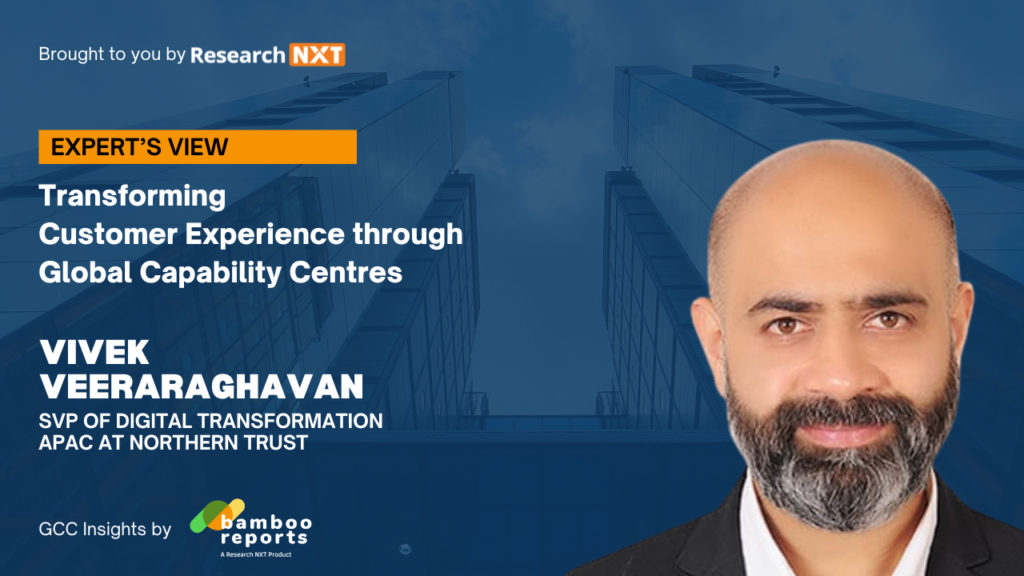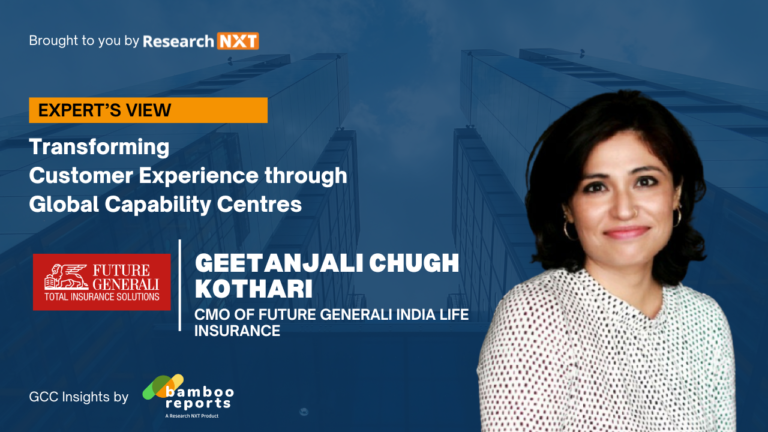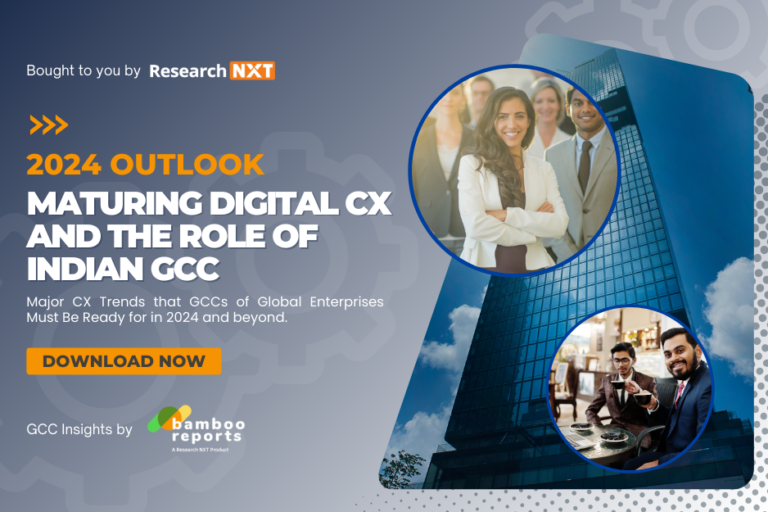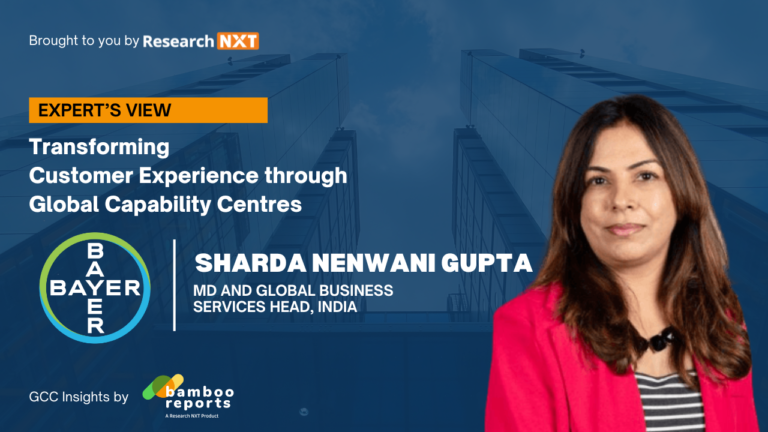
Digital transformations in the post-pandemic scenario have accelerated the need to maintain a balance between the accurate delivery of strategic programs and tactical quick fixes
In this Research NXT Interview, Vivek Veeraraghavan, SVP of Digital Transformation APAC at Northern Trust, talks about his journey and the transformative role of Indian GCCs in Digital Customer Experience (CX). He also highlights the in-house GCC model’s potential and real-world applications, which act as the base of actionable insights to create the whitepaper Leaders Speak: Transforming Customer Experience (CX) through Global Capability Centres.
Key takeaways from this Research NXT interview:
- How the GCC Innovation CoEs deliver turnaround digital transformations for the larger global enterprise.
- How the need for transformation has accelerated over a period of time in the post-pandemic situation.
- The role of GCCs is to provide long-term and sustainable impacts rather than just solving some run-of-the-mill aspects.
- Why it is essential to have the buy-in from senior leadership for any change or transformation initiative.
Could you elaborate on your role and journey at Northern Trust Corporation in India?
Vivek: I have lived all my life here in Bangalore, and I’m a computer science graduate. Coding comes naturally to me as I’ve done coding in C, C++, and COBOL. In 2002, I started my journey in a call centre selling credit cards for the US market. Then, I moved into AXA Insurance in the BFSI space in 2003, where I used to make calls to health insurance providers like hospitals and clinics and capture data. I moved into management roles within three-plus years, and from there, I moved to Fidelity Investments for 6.5 years, primarily performing process transitions by setting up back-office functions.
Eventually, my transition to a non-voice function started with Fidelity in the retirement benefits team. That was my first experience with digital transition. It was more by choice as I was keen on improving the processes and started my journey in Six Sigma by getting trained back in 2007. With my inherent love for statistics and numbers, I started taking an interest in projects involving tools and techniques. I got certified as a green belt and moved into a full-time Six Sigma role in 2009, leading the quality function for the retirement benefits team at Fidelity Investments. I deployed Lean Six Sigma across the organization through multiple projects and training across different regions and sites and also implemented the ideation program for Fidelity back in 2011 and won the President’s Award.
Then, in 2013, I joined Northern Trust with the responsibility of setting up the entire process excellence capability and the Automation Centre of Excellence in India. It’s been a journey from creating an ideation space to using the same for fast-tracking organizational process improvements through various practices. Out there, we used to break down the processes through Kaizen events to fast-track the automation through an agile methodology using Six Sigma fundamentals. We had established a great co-working space comprising cross-functional teams of Six Sigma experts, automation enthusiasts and SMEs, business analysts, testers, etc, for any process improvement initiatives.
Apart from that, I seek to strengthen my learning and development, engage with industry peers, and also encourage my team to participate in industry events, present our case studies, etc. Furthermore, I am an honorary council member of the Data Science Foundation, representing India for the Bureau of Indian Standards in the field of AI.
Wrapping up, I have been a hands-on person who continues to learn because you’re as good in your role only if you know what’s happening on the ground.
As the leader for APAC’s Analytics and Digital Transformation initiatives, what are your observations around the approach at NT in terms of usage of Next-Gen Technology Platforms for digital transformation initiatives, including innovations and product/service launches for improving digital customer experiences?
Vivek: With constant evolution in technology and the changing needs of the customer, organizations are being forced to adapt to deliver service excellence. With a significant part of many global organizations setting up GCCs across India, the need to support and fastrack strategic initiatives have increased. The main reasons are the maturity of GCCs in terms of capability, great domain expertise, and also wealth of talent. India GCCs are being viewed more as a hub for innovation as against just being delivery centres. So, GCCs in India are uniquely positioned to drive more impactful projects and programs for the global organization
Read More
As an industry leader, what is your observation of how things have changed in the post-pandemic scenario in the Financial Services sector, and what are the key CX approaches to look out for while stepping into 2024 and beyond for top BFSI organizations?
Vivek: Great question. So, the need for “Now” is genuine and relevant because that’s the customer expectation and demand at these times. Whether it is a pandemic-induced change is debatable, but we have seen this trend aggressively improve during the pandemic. With the added convenience of obtaining any service, the customer mindset has changed, and it is reflected in the financial services sector equally. For example, we don’t go the traditional way of buying a mutual fund or stock anymore and instead directly access it through an app.
However, having said that the scenario in India is a bit incomparable to that of regions like the Middle East, EMEA, or Europe, where the process is still very manual due to slow adoption rates of digital transformations. But post-pandemic, even these regions are rising to the expectations, and the pressure is building up in the global organizations to deliver to the needs. So, I think it’s a balance between the delivery of strategic programs and tactical fixes to address the in-the-now demand and that too accurately. Further, the need for this transformation has accelerated over a period of time in the post-pandemic situation.
With services automation groups focused on supporting the business strategy initiatives of global enterprises, could you please share some instances of positive Digital CX impacts of these initiatives for the end users?
Vivek: The Indian workforce is viewed from the perspective of its intellectual capability, natural analytical ability, and skills to solve problems. The parent organization recognizes this massive pool of capable talent, which is evident as we were able to take on a few POCs and deliver as per the needs. However, this is a challenging progression, especially for the banking sector, due to the involvement of multiple federal regulations. However, from an Indian perspective, we have slowly but surely been able to establish that seat at the table and have been strategically solving problems at a global level.
Now, with respect to the initiatives that are driven from India for the global organization, we are now seen as alternatives to any consulting entities abroad that could get the job done. Hence, the India capability centre is being leveraged for expertise instead of being just a service provider.
Also, organizations are moving towards building a holistic innovation model comprising three pillars, one of which is the Consulting arm, whose primary goal is to understand the problem in detail, i.e. spending more time on the problem than the solution. Review the problem, understand its implications for connecting upstream and downstream processes, map the dependency of the issue, and finally estimate the impact that the solution may have on the larger organization in the near and long term.
Only when we are convinced of the fact that the implementation of the automation will have a holistic impact on the issue, that’s when we drive improvements. This has also enabled GCCs to align better with some of the strategic programs initiated across the parent organization,
In the context of document processing, GCCs potentially see unstructured document extractions as an industry problem. It has improved, but still needs to be solved.
Do you think Global Capability/Shared Services centres are better poised to enable Global Enterprises in their Digital transformation initiatives than partnering with a third-party service provider? Or do you prefer a hybrid approach of the best in-house and outsourced capabilities in Tech, Talent, and infrastructure needs?
Vivek: As GCCs, we leverage third parties, and the decision to engage with them is vetted very carefully based on many parameters. We work with third-party vendors on RPA and mostly on niche specialty tasks like optical character recognition processes, etc. Having said that, our approach towards the GCC bringing value for the larger organization is to provide long-term and sustainable impacts rather than just solving some run-of-the-mill aspects.
Hence, to achieve this, we need special talent, innovative tools, and tech. We are looking at both sides of the curve and leveraging internal capabilities as well as contractors.
What according to you are the key CX focus areas/challenges that global enterprises of the size of Northern Trust face?
Vivek: I think challenges could be categorized as follows:
- First is ensuring that the talent pool of intellectually motivated individuals within the team is constantly engaged with strategically focused opportunities. This will enable retention.
- Secondly, one crucial point that I have realized over time is that no matter how good a job we do, we should be able to project and articulate all the great work done which will be very relevant to the digital transformation initiative of the global organization.
- Ultimately, we are expected to deliver value, and we should do so through every initiative. As a team, we have to be very agile, open to requirements, and deliver solutions within record timelines. This may look like a daily operational task, but it is very challenging.
We should evaluate the actual need for something to be automated and not just for the sake of it; otherwise, we will end up automating a bad process.
To conclude, please share some essential elements or checks that every Digital Transformation plan should include for successful Digital CX accomplishments.
Vivek: The first thing on the checklist is something I already mentioned earlier, and that is not to dive into solution-finding mode straight away but rather get to know the problem better to ensure the solution is not sub-optimal. A well-defined problem is half the problem solved.
Then, for any change or transformation initiative to start on the right foot, the buy-in from senior leadership is essential. This will happen over time only if they provide evidence of some success at the start itself and then go ahead and scale it. Also, we should evaluate the actual need for something to be automated and not just for the sake of it; otherwise, we will end up automating a bad process.
Thirdly, we should always have a support mechanism with structured governance around it, including SLAs, accelerated turnaround timelines, and strategically accepted and aligned initiatives, to ensure its success.
And, of course, I believe that a team should be built not only on the know-how of technical concepts but also with a good grip on the domain expertise.
These are a few things that I would ideally keep in mind while embarking on any digital transformation journey and ultimately celebrating the outcome.





